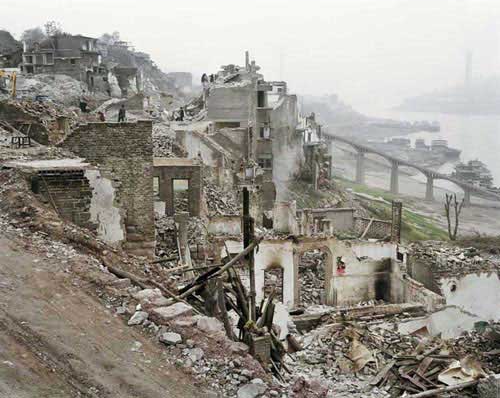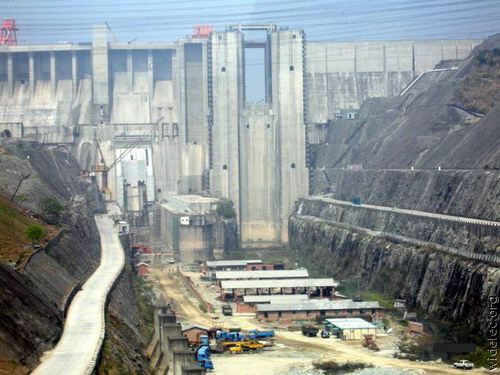Introduction
In due time this project was named as one of the greatest engineering achievements of the twentieth century, but now the dam “Three gorges” on the mighty Chinese river the Yangtze threatens to turn into an ecological catastrophe. Over more than ten years China extolled the civil-engineering design of the biggest hydroelectric power station in the world as the best way to solve a centuries-old problem of flooding along the river basin of Yangtze, and also produce a sufficient, for the quickly growing national economy, capacity of electric power. The building process will last till the end of 2011 for the dam to be fully operational. Ecologists at the beginning of the project’s construction have declared that consequences for the region’s environment will be catastrophic in connection with changes in the ecosystem.
Aims
This report aims to present the general picture of the scale of the aforementioned enormous project. This project has many aspects of influence that include financial, ethical, and environmental. This paper will attempt to deliver the picture specifically in the context of environmental ethics which this project has affected. Another aim of the report is to assess the issues raised from the “Three Gorges” dam project based on ecology, establishing globalization as the pushing factor in continuing the project despite its controversy.
Executive Summary
The largest dam in the world – Three Gorges Dam is situated in China with a height of about 101 meters and a length of 2,309 thousand meters. “Three gorges” is the most expensive and largest dam in all history of the world’s hydroelectricity, and it towers 300 meters over the water level in the Yangtze. The dam construction has used 27 million cubic meters of concrete and within several years an artificial sea of 600 kilometers will be formed. The project cost is about 25 billion dollars, and during the building of the world’s largest dam more than 100 people have been killed and 1.3 million has been settled out of the subsequently flooded territories.
The economic impact of the “Three Gorges” dam includes the predicted revenue, where hydropower generation is estimated to bring 25 billion Yuan annually. Analyzing that prediction, a report by China Three Gorges Project Corporation (CTGPC) shows that “by 2026, its installed hydropower generation capacity will surpass 63.6 million kw, with yearly power generation exceeding 300 billion kwh and the annual revenue of hydropower business topping 60 billion yuan.” (Richard W. Wertz) With such productivity, this expensive project assumingly will recover its expenses between 2015 and 2017.
However, specifically in China, the history of dam building has witnessed several failures, e.g. when “By 1973, 40 percent or 4,501 of the 10,000 Chinese reservoirs with capacities between 10,000 and one million cubic meters were found to have been built below project specifications and unable to control floods effectively.” (Boleslaw Czachor).
Results
The building of the dam created a list of existing and potential problems in different directions. Regarding the effect on nature “more than 80 percent of the region suffers from serious soil erosion, and 40 million tons of silt a year are being deposited into the Yangtze River”, where “Geologists conclude that even without the construction of the Three Gorges Dam, the region’s population has already exceeded the land’s carrying capacity by 15 percent.” (Dai Qing) Additionally, “The dam also would destroy crucial habitat for several dwindling wildlife species, including the critically endangered Chinese river dolphin.”
Additionally, the probable consequences on the environment include “possible disruption to river traffic both during and after the dam’s construction; degradation of the Yangtze River’s water quality, especially in the huge reservoir; damage to surrounding flora and fauna; and the possibility of the dam’s catastrophic failure from earthquakes or other natural calamities.” (Qing, and Sullivan, p. 53).
Findings
Assessing the benefits of the dam, “Despite its huge size, the overall impact of the Three Gorges Dam on hydropower production in China will probably not be that great. An increase of 18,000 MW constitutes less than 25 percent of the planned expansion of 75,000 MW for the year 2010 called for by national economic planners.” (Qing, and Sullivan, p. 53) Additionally, there are many consequences one of which has been mentioned earlier is the “planned displacement of 1.9 million residents from the intended reservoir valley, the largest such population relocation effort in the history of the world.” (Qing, and Sullivan, p. 53).
It can be seen that in case preventive measures are not taken, a catastrophe is inevitable. The dam’s surrounding areas have been brought a serious ecological damage, the consequences of which might be disastrous. In that sense, reaching to economical prosperity at the expense of ecology is an issue of imbalanced development which in turn will not recover the damage done to the ecology. The government should admit to making a mistake in ignoring the warnings that have been issued long before the dam project reached its final stage. It can be seen that projects such as these involve the participation of powerful institutions where “Policies and practices of these institutions affect destinies of lands, rivers and peoples. Changes made on the environment – whether human-designed or by nature – result in consequences that either challenge or reinforce existing social arrangements.” (Virginia Cawagas) One of certain things is that the attention brought to these issues at least helped the people where “the concerns over the Three Gorges project is likely to ensure that the resettlement process will take place in a more humane manner…” (Khondker, p. 63).
Conclusions
The issue of social choice between certain economic profit and inevitable damage pointed in this paper has shown that the project reached the point of controversy where certain measures should be taken. If the issue of urban relocation is a matter that can be solved by the government by establishing funds for resettling the residents of the dam’s surrounding areas, the environmental issue is a threat on a larger scale. It can be seen that going further without taking any precautions will make this project remembered not only for its record-breaking facts but also for being responsible for shifting the ecosystem of the region. The globalization and environmental movements will always dispute priorities; in a way that the first will seek international finances and justify its actions and the latter will protest showing the impact resulted from the globalization’s projects.
Works Cited
“Bank customers asked to protest China dam financing. ” International Wildlife 1999: 9. Career and Technical Education. ProQuest. Web.
Cawagas, Virginia. “GLOBALIZATION: WHEN EVERYTHING IS FOR SALE.” GEEC. 2002.
Czachor, Boleslaw. “THE THREE GORGES DAM AND THE INFLUENCE OF GLOBALIZATION IN CENTRAL CHINA.” Dialogues@Ru. 2004.
Dai Qing. “Three Gorges project threatens soul of China. ” Forum for Applied Research and Public Policy 13.1 (1998): 32-37. Research Library. ProQuest.
Heming, Li, Paul Waley, and Phil Rees. “Reservoir Resettlement in China: Past Experience and the Three Gorges Dam.” The Geographical Journal 167.3 (2001): 195+.
Khondker, Habibul Haque. “Environment and the Global Civil Society.” Asian Journal of Social Science 29.1 (2001): 53
Mufson, Steven. “The Yangtze Dam: Feat or Folly?” Washington Post. 1997. Web.
Qing, Dai, and Lawrence R. Sullivan. “The Three Gorges Dam and China’s Energy Dilemma.” Journal of International Affairs 53.1 (1999): 53.
Wertz, Richard W.. “Special Report:Three Gorges Dam.” Ibiblio. 2008.
Appendix

